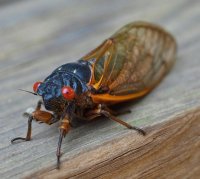mAlice
professional daydreamer
It is once again time for the 17-year cicadas to emerge from the ground. These cicadas are of the genus Magiciada. They are periodical cicadas from brood II and last emerged in 1996, according to cicadamania.com.
They can be recognized by their red eyes, black bodies and orange wing veins. The cicadas will appear in the states of Connecticut, Maryland, North Carolina, New Jersey, New York, Pennsylvania and Virginia.
The cicadas are the offspring of the cicadas that emerged in 1996. They will make their way up from deep below the ground when the soil temperature reaches about 64.5 at least 8 inches down, according to Dan Mozgai, cicada researcher.
"Once they cicadas emerge they only have a life span of two to three weeks," Mozgai said. The cicadas lives can be shortened by the effects of wind and rain on their bodies. Those whose bodies are deformed by the weather won't live as long as the ones who develop normally, he said.
Mature cicadas will mate and the female will lay make a slit in a tree branch and lay her eggs inside. This can be damaging to young trees. Homeowners can protect their small trees by placing garden netting over them. Foil wrapped around tree trunks can also keep the cicadas from climbing up the tree.
"Larger trees may experience some dead branches due to the cicadas," Mozgai said. "But they are generally strong enough to survive with a few dead branches."
Some people will catch cicadas and use them for fish bait. Still others will prepare them to eat.
After a few weeks filled with the sound of cicadas in all the trees, they will die and it will be 17 more years before brood II will be seen again.
They can be recognized by their red eyes, black bodies and orange wing veins. The cicadas will appear in the states of Connecticut, Maryland, North Carolina, New Jersey, New York, Pennsylvania and Virginia.
The cicadas are the offspring of the cicadas that emerged in 1996. They will make their way up from deep below the ground when the soil temperature reaches about 64.5 at least 8 inches down, according to Dan Mozgai, cicada researcher.
"Once they cicadas emerge they only have a life span of two to three weeks," Mozgai said. The cicadas lives can be shortened by the effects of wind and rain on their bodies. Those whose bodies are deformed by the weather won't live as long as the ones who develop normally, he said.
Mature cicadas will mate and the female will lay make a slit in a tree branch and lay her eggs inside. This can be damaging to young trees. Homeowners can protect their small trees by placing garden netting over them. Foil wrapped around tree trunks can also keep the cicadas from climbing up the tree.
"Larger trees may experience some dead branches due to the cicadas," Mozgai said. "But they are generally strong enough to survive with a few dead branches."
Some people will catch cicadas and use them for fish bait. Still others will prepare them to eat.
After a few weeks filled with the sound of cicadas in all the trees, they will die and it will be 17 more years before brood II will be seen again.



